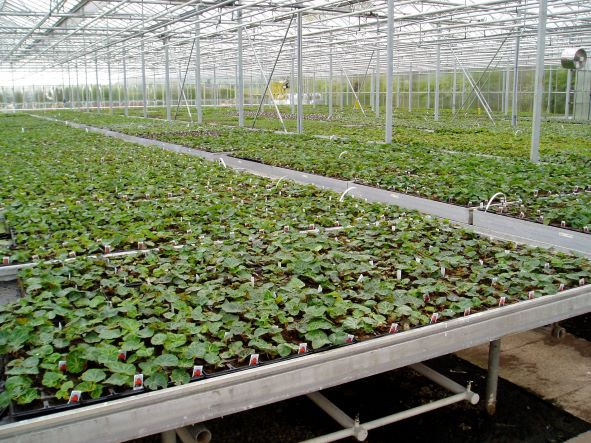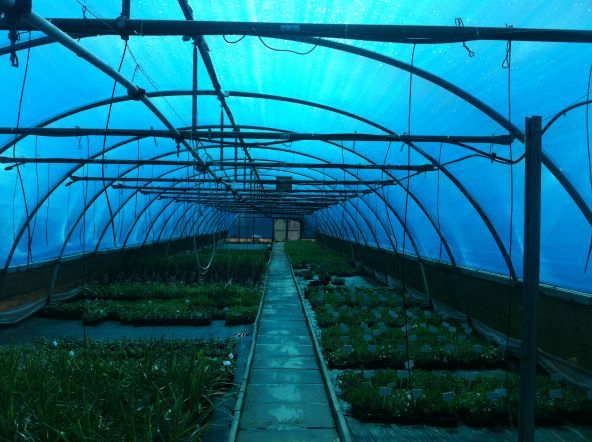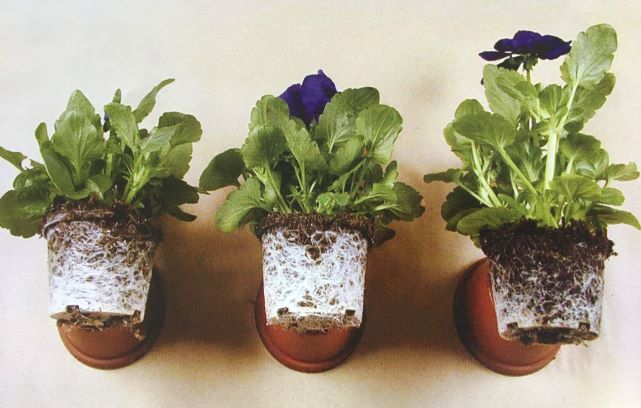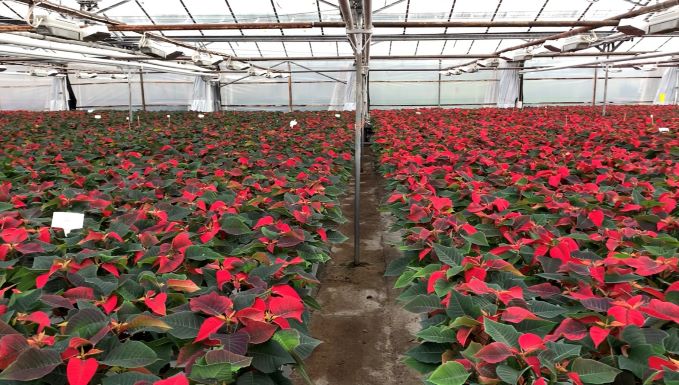Please click here to access the main AHDB website and other sectors.
- Home
- Knowledge library
- Cultural and physical methods of growth control on protected ornamentals
Cultural and physical methods of growth control on protected ornamentals
Temperature, light, nutrition, irrigation and thigmotropism are all factors which can be amended or employed as a method of controlling plant growth.
Plant species should be grouped and grown according to their temperature requirements, thereby preventing excessive stem extension and growth under inappropriate conditions. For example, Alyssum, Antirrhinum, Dianthus and Mimulus have a cool temperature requirement (5–10°C); Dahlia, Fuchsia and Verbena have a moderate temperature requirement (10–15°C) and Begonia, Impatiens and Salvia require warm temperatures of at least 15°C.
DIF and DROP techniques use the difference between day and night temperatures, or a drop in temperature at dawn, to control stretch in many plant species. More compact plants are produced when night temperatures are equal to (zero DIF) or warmer than (negative DIF) day temperatures as stem elongation is reduced. However, when day temperatures are warmer than night temperatures (positive DIF) stem stretch increases.
Ventilation can be used to impose an abrupt dip in air temperature for two to three hours at dawn (DROP) to produce the DIF effect. A combination of DIF and DROP can also be used to produce compact plants of some species.
The effectiveness of these treatments is dependent on the size, duration and timing of the temperature drop, and it can be limited by external temperatures. DIF and DROP both need to be continued until marketing to maintain the effect. Plant species responsive to these treatments include: Ageratum, Cyclamen, Dahlia, Dianthus and Salvia. Alyssum, Lobelia, New Guinea Impatiens and Tagetes are less responsive. Pansy is responsive to a combination of DIF and DROP.
Growing crops under a suitable temperature regime reduces the need for chemical growth control

Courtesy and copyright of ADAS Horticulture.
Light
Light intensity has a positive effect on plant growth. However, different plant species have different optimum light levels for growth and development. Light levels that are too low result in plants becoming etiolated. Conversely, high light levels increase growth rate, but excessive light levels can cause scorch.
Light quality influences stem extension and branching. Within the plant canopy, leaves filter out red light, leaving a greater proportion of far-red light compared to red light, stimulating plants to stretch to reach the light. A higher ratio of red to far-red reduces stem elongation and increases branching through reduced apical dominance. Similarly, higher levels of blue light reduce stretch. There is natural variation in light quality through the day, with the red to far-red ratio decreasing towards the end of the day, producing plants with longer internodes and less branching. Variation in light quality can also be expected due to season and latitude.
Spectral filters (modified plastics) have been developed that modify plant architecture by altering the light spectrum reaching the crop. A range of trials over several years have examined various types of modified plastics on the growth of various ornamental crops. The majority of such trials reached the same conclusion: the spectral filter plastics do indeed have an impact on the growth of some, but not all plant species, and their impact varies with differing light levels through the year. This makes growth management of the wide range of bedding plant species grown on most UK nurseries difficult using this technique alone.
Light diffusing materials (glass, plastics, screens or coatings) have been developed which scatter light entering the structure allowing plants to be exposed to higher levels of radiation without the risk of hot spots causing leaf scorch. Such materials can improve the habit of crops, especially those prone to stress at high light levels.
LEDs offer the capacity to manipulate the light spectrum and design lighting recipes in response to crop needs using bulbs with different outputs. However, the application of such systems in ornamental crops (as opposed to edible crops) is still limited due to the capital costs of such systems and the potential crop premiums generated.
SunSmart Blue spectral filter polythene

Courtesy and copyright of ADAS Horticulture.
Nutrition
Growth can be controlled by varying the nutrient application rate (low levels of base fertiliser prevent rapid early growth), supplementing programmes with liquid feeds (to match feed levels to crop development), using controlled release fertiliser (to provide nutrients as required) or amending the growing media with bark (to absorb excess nutrients). However, care does need to be taken when using these techniques to avoid deficiency symptoms.
The nutrient balance of fertilisers can also be managed to reduce excess growth by:
- Using low ammonium fertilisers during the winter in dull weather conditions, and keeping the proportion of ammonium nitrogen below 50% of the total nitrogen supplied
- Using potassium and calcium nitrate as sources of nitrogen to promote balanced growth
- Incorporating a P-buffer (Compalox-P, 1-2%) into the growing media as the sole source of phosphorus. Reduced (but not limiting) phosphorus levels in the growing medium will produce shorter plants, enhance root development and improve shelf life
Impact of P-buffer in a peat-based growing medium (left and middle) compared to plant without the treatment (right)

Courtesy and copyright of Danish Institute of Agricultural Sciences.
Irrigation
Water deficit stress can be used to slow growth, produce more compact plants (a 10–30% reduction in growth is achievable), improve root growth and enhance shelf life in many plant species (for example Impatiens and poinsettia). Watering plants little and often, and allowing plants to reach wilting point before re-watering is most effective, although overuse of drought stress can affect plant quality and cause premature bud development in plug plants or bud drop in a range of species including Fuchsia and New Guinea Impatiens.
Poinsettia and impact of regulated deficit irrigation (RDI), crop grown with PGRs (left) and RDI (right)

Courtesy and copyright of Mark Else, NIAB EMR.
Thigmotropism
Vibration, shaking or brushing with a solid object (thigmotropism), such as netting or materials passed over crops on a gantry, or even air movement will produce more compact plants, although the effects are variable between plant species, with no response shown by some species. The effect is thought to be due to ethylene production in response to mechanical stress.
Useful links
Further information can be found in AHDB factsheets below:
Precision irrigation scheduling in the production of hardy nursery stock
Authors
Authors – Chloe Whiteside, Jill England and David Talbot, ADAS Horticulture.
Original author – Jill England and David Talbot. ADAS Horticulture.
Webpage content correct as of May 2021.
Topics:
Sectors:
Tags:

